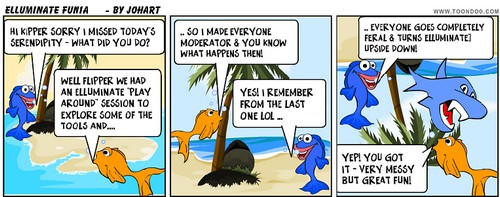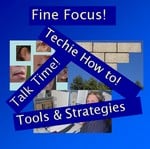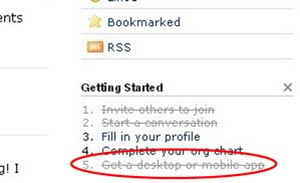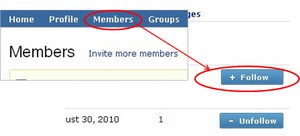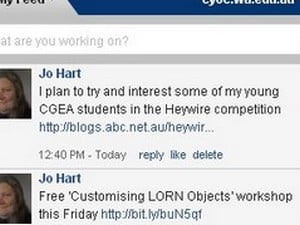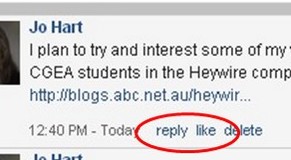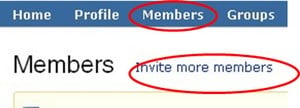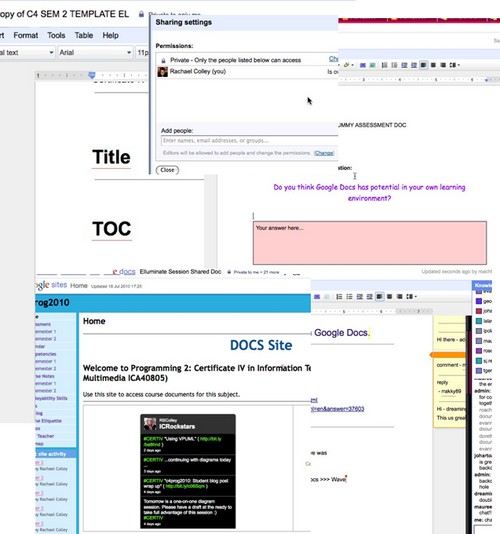Introduction
This excellent Edublogs Fine Focus session (recording here) was our second full session on GoogleDocs in recent weeks. In this session Ellena Bethea (@21stcenturychem) gave us a look at how she uses GoogleDocs in her High School Chemistry context. This provided us with both a great follow on and a “compare and contrast” opportunity to the session two weeks ago when Rachael Colley (@burntsugar) introduced us to some of the features of GoogleDocs and showed us how these have enabled her to go paperless with her vocational IT students.
The Session
This session was a goldmine of ideas and information. Ellena set up a doc for us to experiment with later using a fill in Google form so that we could submit our emails to enable her to give us access to the doc.
The main thrust of the session was a look at how Ellena uses Google forms, spreadsheets, drawing and presentations with her students. Moreover she does this in a situation where computer access for students in the lab situation is minimal. Most student work done through GoogleDocs is done outside school with students collaborating on a variety of tasks sometimes synchronously and sometimes asynchronously.
Ellena used application share to great effect. She used a Google presentation for the session structure. and then shared a wide variety of documents showing how she provides her students with great resources and opportunities to work collaboratively on documents such as lab reports.
Conclusion
This was a fantastic session with just so much useful information. As with the session two weeks ago I learnt so much. I keep seeing more potential uses for GoogleDocs with my distance students.
Next Week
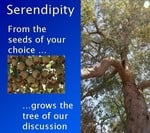 Our next Webinar is an Edublogs “Serendipity” session, one of our fortnightly unconference sessions where we invite you to bring along your “hot topics” and “burning issues” for our poll on the topic of the day. If you want to propose a topic in advance then visit the Serendipity Wallwisher and add your topic. Then join us on Thursday Sept 30th at 23:00 GMT/UTC (7pm USA EST, Midnight BST) or Friday Oct 1st at 1am CEST,7am West Aus, 9am NSW, depending on your timezone – in the usual Elluminate room
Our next Webinar is an Edublogs “Serendipity” session, one of our fortnightly unconference sessions where we invite you to bring along your “hot topics” and “burning issues” for our poll on the topic of the day. If you want to propose a topic in advance then visit the Serendipity Wallwisher and add your topic. Then join us on Thursday Sept 30th at 23:00 GMT/UTC (7pm USA EST, Midnight BST) or Friday Oct 1st at 1am CEST,7am West Aus, 9am NSW, depending on your timezone – in the usual Elluminate room
In the Future
If you are a regular visitor to our webinars you will know that we alternate “Fine Focus” sessions on specific topics with “Serendipity” the unconference sessions where we choose a topic by poll at the start of the session. Sometimes the very fact of being asked for “hot topics” or other ideas for discussion or learning tends to make our minds blank. This has prompted me to start a Serendipity Wallwisher for topic suggestions. Please visit the wall and add your ideas for Serendipity topics so that we have more choices to consider. Some of these ideas might also form the basis for future “Fine Focus” sessions.


